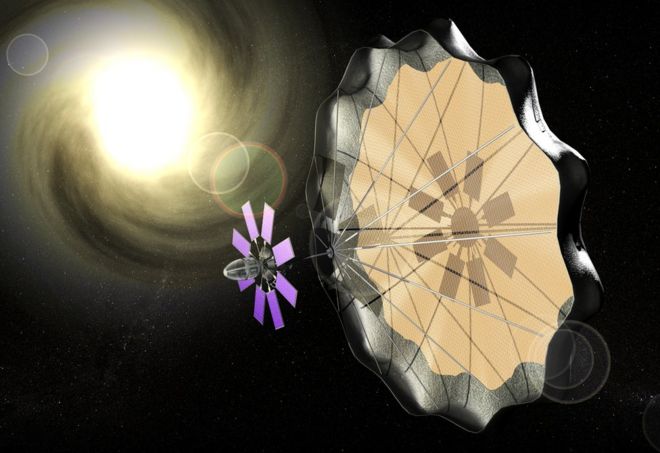Stephen Hawking is backing a project to send tiny spacecraft to another star system within a generation.

They would travel trillions of miles; far further than any previous craft.
A $100m (£70m) research programme to develop the computer chip-sized "starships" was launched by the billionaire Yuri Milner, supported by Facebook founder Mark Zuckerberg.
Interstellar travel has long been a dream for many, but significant technological hurdles remain.
But Prof Hawking told BBC News that fantasy could be realised sooner than we might think.
"If we are to survive as a species we must ultimately spread out to the stars," he said.
"Astronomers believe that there is a reasonable chance of an Earth-like planet orbiting one of the stars [in] the Alpha Centauri system. But we will know more in the next two decades from ground based and space based telescopes.
"Technological developments in the last two decades and future make it possible in principle within a generation."
Prof Hawking is backing a project by Mr Milner's Breakthrough Foundation, a private organisation funding scientific research initiatives that government funders think to be too ambitious.
Expert group
The organisation has brought together an expert group of scientists to assess whether it might be possible to develop spaceships capable of travelling to another star within a generation and sending information back.
The nearest star system is 40 trillion km (25 trillion miles) away. Using current technology it would take about 30,000 years to get there.
The expert group concluded that with a little more research and development it might be possible to develop spacecraft that could cut that journey time to just 30 years.
"I'd have said that even a few years ago travel to another star at that kind of speed would not be possible," said Dr Pete Worden, who is leading the project. He is chairman of the Breakthrough Prize Foundation and a former director of Nasa's Ames Research Center in California.
"But the expert group figured out that because of developments in technology there appears to be a concept that appears to work."
The concept is to reduce the size of the spacecraft to about the size of a chip used in electronic devices. The idea is to launch a thousand of these mini-spacecraft into the Earth's orbit. Each would have a solar sail.
This is like a sail on a boat - but it is pushed along by light rather than the wind. A giant laser on Earth would give each one a powerful push, sending them on their way to reaching 20% of the speed of light.
It sounds like science fiction but Yuri Milner, who was named after Yuri Gagarin by his parents, believes that it is technically possible to develop these spacecraft and get to another star within our lifetimes.
"The human story is one of great leaps," he said. "Fifty-five years ago today, Yuri Gagarin became the first human in space. Today, we are preparing for the next great leap - to the stars."
Challenging work
There are many problems to be overcome before the first spaceships capable of going to other stars are built. These include miniaturising cameras, instruments and sensors so they fit on a chip, developing a solar sail strong enough to be blasted by a powerful laser for several minutes and find a way to get pictures and information of the new star system back to Earth.
Prof Sir Martin Sweeting, who is a researcher at the Surrey Space Centre and head of Surrey Satellite Technology in Guildford, wants to be involved in the project.
He founded a company 30 years ago that reduced the size and cost of satellites.
"A lot of what we did in the 1980s was considered very wacky but now small satellites are considered all the fashion. This (project to go to another star) is currently a wacky sounding idea but technologies have moved on and now it is not wacky it's just difficult," he told BBC News.
Prof Andrew Coates of the Mullard Space Science Laboratory, which is part of the University of London, agreed that the project would be challenging, but not impossible.
"There would be significant difficulties to solve such as ruggedisation for the space radiation and dust environment, instrument sensitivity, interaction of the high power accelerating laser with the Earth's atmosphere, spacecraft stabilisation and power provision.
"But it is a concept worth looking at to see if we could really reach another star system within a human lifetime."
But Prof Hawking believes that what was once a distant dream can and must become a reality within 30 years.
"There are no greater heights to aspire to than the stars. It is unwise to keep all our eggs in one fragile basket," he told BBC News.
"Life on Earth faces dangers from astronomical events like asteroids or supernovas".
http://www.bbc.co.uk/news/science-environment-36025706



